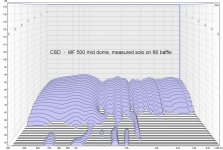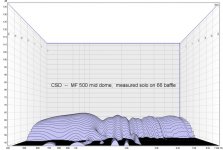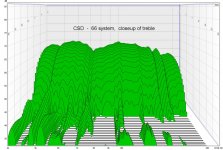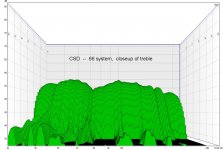Our old Open University gave the 1/19 term as giving a reasonable square wave .
1f1 + 1/3f3 +1/5f5 + 1/7f7 + 1/9f9 +1/11f11 + 1/13f13 + 15f15 + 17f17 + 1/19f19.....
For a triangle
1f1+ 1/9f3 + 1/25f5 / 1/49f7 ....... Basically the square of odd harmonics .
Thus I say 44.1 / 38 = 1.16 kHz is the best in square wave a CD player can give . I must try it sometime as it might have little tricks it performs . If we take the Nyquist principle of the last sine wave it can make is 22.05 kHz then it must be so . Even if we take the 1/15 term we only get 1.47 khz . At that point ripple can be seen .
I liked Sugden A48 . The slightly drier quality over the class A Sugden is not detrimental . Meridian 105 and Quad 405 also . Yamaha might suit of the period . NAD might be OK and Rotel . Denon PMA 250 should be good . I have more reserve about modern amps . Cambridge perhaps ? Sony TA5650 if you ever see one . Preferably one that runs red-hot .
I call the outside a dielectric as it has sonic qualities like a dielectric . True it is one sided so not a dielectric in the function of the device . A word used out of context. This happens when stepping away from the conventional thinking . One has no words . The capacitor plastic skin should be removed as it can like the dielectrics have sonic qualities and does see an electron charge ( put meter to can and one terminal in use to see voltage ) . Unlike the dielectric it was not chosen for anything other than appearance .
The Celestion tweeter was expensive . I suspect the move to aluminum was fashion ( EFOS , MA ) and cost . The notch filter was well liked as it helped the early CD players . I must say the lack of output was the only treble defect . It was stepped down . I remember one day I was on stop from Celestion , Adam said don't worry and place an order anyway . He them turned the page to a famous guitar amplifier maker . They were on stop for £1 000 000 . Adam was still supplying them . Adam was super rep because he had worked in production and knewwhat he was talking about . He knew the SL6 very well . The tweeter was electroplated so as to have no stress due to pressing .
1f1 + 1/3f3 +1/5f5 + 1/7f7 + 1/9f9 +1/11f11 + 1/13f13 + 15f15 + 17f17 + 1/19f19.....
For a triangle
1f1+ 1/9f3 + 1/25f5 / 1/49f7 ....... Basically the square of odd harmonics .
Thus I say 44.1 / 38 = 1.16 kHz is the best in square wave a CD player can give . I must try it sometime as it might have little tricks it performs . If we take the Nyquist principle of the last sine wave it can make is 22.05 kHz then it must be so . Even if we take the 1/15 term we only get 1.47 khz . At that point ripple can be seen .
I liked Sugden A48 . The slightly drier quality over the class A Sugden is not detrimental . Meridian 105 and Quad 405 also . Yamaha might suit of the period . NAD might be OK and Rotel . Denon PMA 250 should be good . I have more reserve about modern amps . Cambridge perhaps ? Sony TA5650 if you ever see one . Preferably one that runs red-hot .
I call the outside a dielectric as it has sonic qualities like a dielectric . True it is one sided so not a dielectric in the function of the device . A word used out of context. This happens when stepping away from the conventional thinking . One has no words . The capacitor plastic skin should be removed as it can like the dielectrics have sonic qualities and does see an electron charge ( put meter to can and one terminal in use to see voltage ) . Unlike the dielectric it was not chosen for anything other than appearance .
The Celestion tweeter was expensive . I suspect the move to aluminum was fashion ( EFOS , MA ) and cost . The notch filter was well liked as it helped the early CD players . I must say the lack of output was the only treble defect . It was stepped down . I remember one day I was on stop from Celestion , Adam said don't worry and place an order anyway . He them turned the page to a famous guitar amplifier maker . They were on stop for £1 000 000 . Adam was still supplying them . Adam was super rep because he had worked in production and knewwhat he was talking about . He knew the SL6 very well . The tweeter was electroplated so as to have no stress due to pressing .
Last edited:
Which amplifier did you use between signal generator and 66 when you did the measurements for the Celestion drive units, especially when for the tweeters
I used the Sugden A28 before reconditioning it.
Also, do you hear a loud, or quiet, thump sound through the speakers when you switch on the A28, now that it has no Relay ?
Yes, an audible thump. About the same level that occurs when I turn off the valve power amp. I'll probably install a new relay - Michel has suggested a suitable replacement - Omron G2R-24-DC24. Plugging in a set of headphones disconnects the speakers so this is one way of preventing the thump.
Music to listen to tweeters: Soprano vocals' highest harmonics will mostly be in the upper midrange, and only a little into the low treble.
Soprano will be good for upper midrange fine tuning then.
For a reasonable quantity of instrument harmonics into the high treble there is really only Violin and Piccolo for pitched instruments, and cymbals and very small bells otherwise.
The 66's are excellent in the high treble then because I listen to a bit of (mainly) ECM label jazz music with great musos. These discs have well recorded piano, double bass, drums, some sax and violin occasionally. Cymbals, high hats and cow bells sound excellent so maybe the area for fine tuning is centered on the upper mid rather than the treble.
I find solo violin recordings useful to hear quality of tweeters. Do you have any recordings of unaccompanied violin playing ?
I have one solo violin double disc - Bach Sonatas & Partitas by a local muso, Richard Tognetti playing a Guadagnini (recorded 2005). This sounds quite good. Not as good as hearing Tognetti live but not bad at all. This might be good for fine tuning as well as the soprano discs.
I have many other discs with violin so will pick through these.
I can list a few that I think are musical, because there is little point in buying something you cannot stand to listen to
Is there a particularly good one you can suggest Alan?
I don't have access to audioXpress
Hi Alan,
thanks for mentioning the AudioXpress / D'Appolito article about splicing nearfield and farfield measurements... and wouldn't you just know it, nearfield mic placement is super critical.
Hmm, I wonder if nearfield is something I would want to take on! With my bad luck there seems to be no end to what can go wrong.
I mean, after putting a big chunk of time and effort into my first measurements, an analysis of the impulse responses revealed pollution where there shouldn't have been any (because of the attention paid to speaker & mic placements, and to boundaries).
I tell you... I was exhausted after manipulating all the software and measurement components in order to tease out a solution to the pollution and to make a corrected set of measurements.
D'Appolito also talks about a second low-frequency measurement method (measuring inside the enclosure), but the free preview of AudioXpress ended on the page where that discussion begins. I'll have to keep an eye out for the full article.
link to free preview= AudioXpress - June 2012
I also came across another AudioXpress / D'Appolito measurement article that is informative
link= http://www.audioamateur.com/media/dappolito2959.pdf
zip file= View attachment dappolito - speaker measurements.zip
Thanks again Alan!
thanks for mentioning the AudioXpress / D'Appolito article about splicing nearfield and farfield measurements... and wouldn't you just know it, nearfield mic placement is super critical.
Hmm, I wonder if nearfield is something I would want to take on! With my bad luck there seems to be no end to what can go wrong.
I mean, after putting a big chunk of time and effort into my first measurements, an analysis of the impulse responses revealed pollution where there shouldn't have been any (because of the attention paid to speaker & mic placements, and to boundaries).
I tell you... I was exhausted after manipulating all the software and measurement components in order to tease out a solution to the pollution and to make a corrected set of measurements.
D'Appolito also talks about a second low-frequency measurement method (measuring inside the enclosure), but the free preview of AudioXpress ended on the page where that discussion begins. I'll have to keep an eye out for the full article.
link to free preview= AudioXpress - June 2012
I also came across another AudioXpress / D'Appolito measurement article that is informative
link= http://www.audioamateur.com/media/dappolito2959.pdf
zip file= View attachment dappolito - speaker measurements.zip
Thanks again Alan!
Copy that audioXpress article !
Hi sba,
thankyou for finding and posting the Link to the free preview of the June 2012 audioXpress article !
Thankyou also for the Link to the 2009 D'Appolito article.
I think I have read that one, but I'll read it again when I have time available.
The first Link to the 2009 article opens OK on this computer here,
but I could not get the File to do anything in the second Link, {my lack of skill likely, but perhaps an overly *protected* computer here.
Anyway, I am presuming the second Link is to the same 2009 article, yes/no ?
Hi Denny,
Print that June 2012 article before the Free Preview is taken down.
You do not need to join the web-site to open it.
Just click on the Preview button,
then on the next screen at the bottom click on the Right pointing arrow.
That will display 2 sets of 2 pages each that can be enlarged.
There is enough there to be of use to you.
I will read the remainder of the article later to see if anything else useful for this project,
and if so I'll post about it here.
I have D'Appolito's book: Testing Loudspeakers
that is in the list at the end of the 2009 article.
I have not had time to read all of it, but what I have read is very good,
however there is a lot in it, and more than you will need to finish your Celestion 66 upgrades.
I have read other of D'Appolito's "audioXpress" published articles,
and to date found only one thing to disagree with him about,
but as that is simply relevant to how different people's brains allocate different orders of priority to some audible phenomena, it does not reduce the quality of other things he discusses ... and he does have more experience than I do !
Hi Nigel !
I have to Log Off now.
I'll be back when I have time available.
Hi sba,
thankyou for finding and posting the Link to the free preview of the June 2012 audioXpress article !
Thankyou also for the Link to the 2009 D'Appolito article.
I think I have read that one, but I'll read it again when I have time available.
The first Link to the 2009 article opens OK on this computer here,
but I could not get the File to do anything in the second Link, {my lack of skill likely, but perhaps an overly *protected* computer here.
Anyway, I am presuming the second Link is to the same 2009 article, yes/no ?
Hi Denny,
Print that June 2012 article before the Free Preview is taken down.
You do not need to join the web-site to open it.
Just click on the Preview button,
then on the next screen at the bottom click on the Right pointing arrow.
That will display 2 sets of 2 pages each that can be enlarged.
There is enough there to be of use to you.
I will read the remainder of the article later to see if anything else useful for this project,
and if so I'll post about it here.
I have D'Appolito's book: Testing Loudspeakers
that is in the list at the end of the 2009 article.
I have not had time to read all of it, but what I have read is very good,
however there is a lot in it, and more than you will need to finish your Celestion 66 upgrades.
I have read other of D'Appolito's "audioXpress" published articles,
and to date found only one thing to disagree with him about,
but as that is simply relevant to how different people's brains allocate different orders of priority to some audible phenomena, it does not reduce the quality of other things he discusses ... and he does have more experience than I do !
Hi Nigel !
I have to Log Off now.
I'll be back when I have time available.
Hi everyone . This is my favorite thread . I had a motorcar called a Montego Diesel . Some would be so ashamed to admit it as to never show their faces again . It turns out is had the superior division of RR develope the engine ( Perkins ) . Tin worm got it in the end ( rust ) . The handling was superb and it refused to use any fuel ( 61 MPG 4.6 L / 100 Km ) . 161 00 miles and zero problems . The engine was as good as new ( better ) . I now have Golf . It's OK . I ran it on Chinese tyres called Runway , also superb ( grip ) .
I know car talk is disapproved of . However the Ditton 66 would be to some the same as the above to ignorant people . This is the problem with people , they need to be in fashion . I would have loved to have developed that car . I would have gone to Pinifarena for some good looks . It would have used decent metal . More fashionable tyres ( not daft ones that brake the spine and bank ) . Also an inter-cooler . I know my love of the M is unique . When I had all the trouble in the world and extra that car never let me down . I ran it for a genuine £1000 a year excluding the inevitable's ( tax , insurance , fuel )
My friend covered his speakers in carpet . In his opinion the damping was in the wrong place in speakers . A Russian speaker I took to pieces had no damping . It had the best bass I ever heard for size of box . How come ? In side it has a double ported internal baffle ( all plywood box , Latvian ? ) . The ports different sizes . This seemed to roll off the bass . The NAD302 my friend uses with them has the standard 100 Hz tone controls . This restores the output . I want to build a carpet speaker and give it a plywood outer sleeve . The friend also had a broomstick between the speaker and the wall . The speakers were on stands that tilted upwards ( about 15 degrees ) . The back of the speaker had weights attached by chains . These were Celestion cheapo SL6 clones ( forget the number , very nice )
I know car talk is disapproved of . However the Ditton 66 would be to some the same as the above to ignorant people . This is the problem with people , they need to be in fashion . I would have loved to have developed that car . I would have gone to Pinifarena for some good looks . It would have used decent metal . More fashionable tyres ( not daft ones that brake the spine and bank ) . Also an inter-cooler . I know my love of the M is unique . When I had all the trouble in the world and extra that car never let me down . I ran it for a genuine £1000 a year excluding the inevitable's ( tax , insurance , fuel )
My friend covered his speakers in carpet . In his opinion the damping was in the wrong place in speakers . A Russian speaker I took to pieces had no damping . It had the best bass I ever heard for size of box . How come ? In side it has a double ported internal baffle ( all plywood box , Latvian ? ) . The ports different sizes . This seemed to roll off the bass . The NAD302 my friend uses with them has the standard 100 Hz tone controls . This restores the output . I want to build a carpet speaker and give it a plywood outer sleeve . The friend also had a broomstick between the speaker and the wall . The speakers were on stands that tilted upwards ( about 15 degrees ) . The back of the speaker had weights attached by chains . These were Celestion cheapo SL6 clones ( forget the number , very nice )
Print that June 2012 article before the Free Preview is taken down.
I just looked at this thread because I thought something must be happening on it (my auto email didn't arrive this time) Thanks guys, I managed to print the two pages.
actually 4 pages ...
Actually there is 4 pages there albeit set out as 2 pages of 2 pages.
If you got it all you shold have on the final page:
Figure 5a , 5b , 6 , 7 ,
and the last sentance of the page is:
"It is in decibels in Figure 6 for a starting frequency, fo, of 20 Hz."
---
I regret I have very little time available, but I will be back with more about this, and the rest of what we have started as soon as I can.
Actually there is 4 pages there albeit set out as 2 pages of 2 pages.
If you got it all you shold have on the final page:
Figure 5a , 5b , 6 , 7 ,
and the last sentance of the page is:
"It is in decibels in Figure 6 for a starting frequency, fo, of 20 Hz."
---
I regret I have very little time available, but I will be back with more about this, and the rest of what we have started as soon as I can.
Measurements wrt sba #884 above
OK, I've re-read both of J. D'Appolito's articles.
From #884 above:
link = http:// ...... dappolito2959.pdf
This is very good to describe basics to readers new to measurements.
I refer particually to Page 3 - read carefully about the limitations of the measurement technique, etc ...
Also, in his mention of Diffraction effects disappearing off-axis,
I add that the magnitudes of the On-axis diffraction effects will usually reduce when measured Off-axis,
however there often occurs additional diffraction effects when measured Off-axis.
Refer to FIGURE 12 and you can see some if you carefully compare the Off-axis with the Grille Off plot in the FIGURE 11.
Back to FIGURE 11 - those Diffraction effects are caused by a Grille Frame, however any raised edges around the front baffle of a loudspeaker cabinet will cause similarly sized effects
- in particular with Celestion 66 that top of cabinet lip -{which I have several times mentioned in this thread}.
The reflection from that lip is too close in time to effectively gate out,
because if the gate time is set short enough to close before the lip caused reflection arrives there will be some loss of resolution of midrange signal data, thus some degree of error in the then displayed measurement.
Even when no raised edges around the cabinet, there is diffraction - simply from the 90 degree angles of front to sides of cabinet,
however the magnitudes of effects of those are less than from raised edges.
An Experiment:
If you want to try to visualize 90 degree angle diffraction, turn on the water through a Hose to high pressure,
then point the stream to the edge of a corner of a building.
Vary the angle from end of hose to edge of building till you see maximum effect.
See how the stream of water breaks up into an arc of many streams which splay over a wide angle around the edge.
If the pressure of the water could be got high enough that arc would widen further and include some spray back towards the hose.
In this example higher pressure = treble frequencies' sound.
Water pressure though a garden tap and hose cannot be got high enough to cause some reflection directly back to the end of the hose,
but treble frequencies' intensity is high enough to cause some reflection back towards a front placed microphone or listener.
Page 4 is CSD measurements - if any of you have computer programs to do those,
and then refer to Page 5 and further.
NOTE: the data in FIGURE 10 is to be compared to that in FIGURE 5, and not to FIGURE 7.
--- --- --- --- ---
I can't get "zip file = Attachment 290194" to open on either of 2 different computer systems I have been able to try.
To anyone reading who has been able to open it - is it the same article as the "link = http:// ..... dappolito2959.pdf" ?
{ sba ? }
--- --- --- --- ---
The "AudioXpress - June 2012" article:
Relevant to what we are doing in this thread - examining the drivers and crossover - the 1st and 2nd pages are sufficient.
Denny,
you can do some measurements that are not extreme Nearfield.
Refer to Figure 1 and Figure 2.
If you have a Gate you can apply it as sba has done,
but if no gate then what one does is place very absorbent material at the point where d2 hits the floor in Figure 1.
In this case it is practical to reduce d1 to somewhere between 1 foot <--> 2 feet, because there will be reflections from ceiling and side walls that are not easily absorbed,
thus we want to get maximum intensity from speaker to microphone, and less from other reflecting surfaces,
BUT, the closer the mic. is to speaker the less linear the measurement is
- that is, it starts to look like a Nearfield - humped in centre of plot - when the mic. is close to the speaker,
so you will have to experiment with d1 ,
and also because 66 cabinet is tall, thus fairly soon reflections from ceiling.
I would put one cabinet at the centre of the smaller horizontal dimension of the room,
and with its back a smaller distance to the wall behind, so that its front and the microphone are a larger distance from the wall behind the mic. AND that distance NOT equal to side-of-room-to-mic. but larger, as much as possible.
With mic. at tweeter height start with mic. 1 foot in front of tweeter.
On the floor between mic. and speaker put a soft pillow - wool or polyester/tontine filled, not closed cell foam.
{Pillow and mattress foams are closed cell and thus reflect some sound. Genuine acoustic foams are open cell, but not all the cheap ones are fully open.}
Pillow cover should be cotton or a woven thread, but not a plastic weave which will reflect part of the sound, particually the treble.
Angle the pillow on its long-side edge so as to have reasonable thickness for absorption -{this will be particually necessary when measuring the mid domes which go to lower frequencies and need deeper absorbents}.
Better would be to get a soft fibreglass insulation batt and cut some pieces the width of the 66 and between 6" <--> 1 foot high and stand on edge positioned so that the open cut edge is facing up.
The sealed sides of those batts partially reflect mids and treble, though they do absorb lowest mids and upper bass frequencies to some degree,
thus direct the sound towards open cut edges of the fibreglass batt.
Another option is loose pile a Wool blanket in that floor space to as high as possible.
Use real wool, not poly because poly does not absorb well enough and there will be reflections back through it from the floor, at least in the midrange.
If you can suspend a pillow on the ceiling directly above the d2 floor point it will reduce measurement errors significantly.
Another pillow at mic. height on wall behind mic. directly in line will be helpful if possible to do.
Do not stand near mic. when test signal is on, because your body will cause some reflections - particually in the midrange.
If the result looks too humped at 1 foot d1, increase d1 to 2 feet and do another,
but at 2 feet the reflections from the room will corrupt the measurement significantly more.
Do the above with tweeter disconnected from the crossover.
For other tweeter, put it in first tweeter's cabinet, or put second cabinet in exactly the same position in room as first was.
{Masking tape a rectangle on the floor of the position.}
Any measurement error will then be the same for both tweeters, thus we can see whatever differences between tweeters in one of your comparison type plots.
One 66 cabinet in the room only, but if not possible to take one out, then put it behind the one being measured - directly back-to-back with drivers facing the wall behind.
If you get clear enough measurements with the tweeters you can measure the mid domes the same way,
though as they will be a bit closer to floor, and lower frequencies do not absorb as well there may be errors in low midrange.
I do not know if d2 will be better at 1 foot or 2 feet for midrange, thus you may have to try both.
Again, we are primarily concerned with differences between the drivers,
and not so much the inevitable measurement error which will be the same for all drivers in the same mids' position.
Again, disconnect dome from crossover.
If you want to do a with versus without crossover comparison plots for any driver then a load resistor MUST be connected across the outputs for the drivers not being measured, or there will be short circuits through the crossover at some frequencies which are high risk for the amplifier.
Cheap 10 watt wirewound resistors are OK for substitute loads at the low levels you will be testing at.
Substitute 3.9 or 4.7 ohms for woofer and tweeter, and 6.8 or 7.5 or 8.2 {maximum} ohms for mid.
Tweeters' comparison is mostly what we need to solve your balance problem,
but do mid domes if you want to.
The woofers are too close to the floor to be able to do low error measurements with the above, particually in the bass, but you may get something meaningful for the woofer response in the midrange region the crossover needs to filter off, though d1 would have to be 1 foot, unless the absorptive on floor is very good.
Back to D'Appolito's article:
sba,
see the B plot in Figure 3. This type of Ripple was present in the upper midrange in some of your dome plots - I suspect caused by the 66 cabinet, because the ripple was at higher frequencies.
For the adding of driver and port plots to see bass response,
same Nearfield technique can be used with mic. at centre of the 66 ABR as if it was a port/vent.
Really though you do not need to measure the bass, as Celestion got the alignment close enough to ideal for even bass spectrum response down to frequencies lower than are on almost all music recordings.
It is only from about 250 Hz upwards we are concerned about to evaluate the effectiveness of the crossover and to consider if small changes to it may produce better results,
thus Cone only measurement is sufficient, and between 250 Hz <--> 1kHz , though to higher frequencies is interesting to see full result of the crossover in comparison plots.
The missing pages:
There are two more pages -{actually 1 + 2/3 because there is a 1/3 page strip advertisment on final page edge}.
Page 5 text begins:
"Now the process is very simple. All you need is an AC voltmeter with a decibel scale, an audio oscillator, a good microphone, and an amplifier."
My comments after reading the remainder:
This test requires an oscillator that can be manually swept.
A broadband test signal will not work.
This test is practical only from lowest bass frequency up to the 1/8th wavelength.
When internal cabinet height is larger than 1/8th of the wavelength being measured there begins excess phase subtraction.
When 1/4 wavelength is reached the result is largely inaccurate, and more-so as frequency is raised.
Also it is not a fully Linear test - the Figure 6 correction scale has to be applied.
Because of that the signal level needs to be largest at the lowest frequencies or there is a Signal-to-Noise error in the results.
Large amplitude signal at lowest frequencies causes non-linearity of the woofer and vent/port -{or ABR reaction in the 66}, thus will deviate from correct result unless the woofer can handle a lot of power.
Small vents cannot disperse a lot of power, but the large ones in PA systems and large Studio Monitors can,
{thus your JBL speakers may work with this technique sba, though I think JBL got the low bass as close to optimum as practical, and doesn't need measurement. Do an Impedance versus Frequency plot through the bass of your JBLs, as that can indicate how low in frequency they will play without excess distortion, and is easier to do than this MIB measuring}.
About MIB versus Nearfield, D'Appolito's conclusion is that MIB may be more accurate at the lowest frequencies and Nearfield more accurate in upper bass to low mids {and MIB dependant on internal Height of cabinet}.
He plotted an Average of both added.
Really, to accurately measure lowest bass one needs a very large Anechoic Chamber, or cabinet on a very tall mast in a very quiet outdoor location on a no wind day, or a 2pi test done outdoors - that is with cabinet in a rectangular hole in ground with its front level with top of ground, and a correction factor applied as frequency is reduced.
D'Appolito used a "MLSSA 10.3 acoustic data acquisition card" to do the tests for the plots shown.
The REFERENCES listed are:
[1] - D. B. Keele, "Low-Frequency Loudspeaker Assessment by Near-Field Sound Pressure Measurement," Journal of the Audio Engineering Society, 1974.
[2] - J. A. D'Appolito, "Testing Loudspeakers", Audio Amateur Press, 1998.
[3] - J. E. Benson, "Theory and Design of Loudspeaker Enclosures," IREE (Australia), 1969.
{I have read Benson - he is VERY mathematical - lots of equations, etc ... and not much for non-mathematician readers.}
[4] - R. H. Small, "Simplified Loudspeaker Measurements at low Frequencies," Journal of the Audio Engineering Society, 1972.
--- --- --- --- ---
I think I have been reading and sending more from/to USA in recent years than anywhere else in the world, given this "Hi" greeting I address everyone !
Now I will change to Nation specific, thus:
Hi sba ,
G'day Denny ,
'ullo Nigel , {or would you prefer "Wotcha Guv" ?}.
I have to log-off now, but I'll be back with more about the other matters we have been discussing as soon as I have time available.
OK, I've re-read both of J. D'Appolito's articles.
From #884 above:
link = http:// ...... dappolito2959.pdf
This is very good to describe basics to readers new to measurements.
I refer particually to Page 3 - read carefully about the limitations of the measurement technique, etc ...
Also, in his mention of Diffraction effects disappearing off-axis,
I add that the magnitudes of the On-axis diffraction effects will usually reduce when measured Off-axis,
however there often occurs additional diffraction effects when measured Off-axis.
Refer to FIGURE 12 and you can see some if you carefully compare the Off-axis with the Grille Off plot in the FIGURE 11.
Back to FIGURE 11 - those Diffraction effects are caused by a Grille Frame, however any raised edges around the front baffle of a loudspeaker cabinet will cause similarly sized effects
- in particular with Celestion 66 that top of cabinet lip -{which I have several times mentioned in this thread}.
The reflection from that lip is too close in time to effectively gate out,
because if the gate time is set short enough to close before the lip caused reflection arrives there will be some loss of resolution of midrange signal data, thus some degree of error in the then displayed measurement.
Even when no raised edges around the cabinet, there is diffraction - simply from the 90 degree angles of front to sides of cabinet,
however the magnitudes of effects of those are less than from raised edges.
An Experiment:
If you want to try to visualize 90 degree angle diffraction, turn on the water through a Hose to high pressure,
then point the stream to the edge of a corner of a building.
Vary the angle from end of hose to edge of building till you see maximum effect.
See how the stream of water breaks up into an arc of many streams which splay over a wide angle around the edge.
If the pressure of the water could be got high enough that arc would widen further and include some spray back towards the hose.
In this example higher pressure = treble frequencies' sound.
Water pressure though a garden tap and hose cannot be got high enough to cause some reflection directly back to the end of the hose,
but treble frequencies' intensity is high enough to cause some reflection back towards a front placed microphone or listener.
Page 4 is CSD measurements - if any of you have computer programs to do those,
and then refer to Page 5 and further.
NOTE: the data in FIGURE 10 is to be compared to that in FIGURE 5, and not to FIGURE 7.
--- --- --- --- ---
I can't get "zip file = Attachment 290194" to open on either of 2 different computer systems I have been able to try.
To anyone reading who has been able to open it - is it the same article as the "link = http:// ..... dappolito2959.pdf" ?
{ sba ? }
--- --- --- --- ---
The "AudioXpress - June 2012" article:
Relevant to what we are doing in this thread - examining the drivers and crossover - the 1st and 2nd pages are sufficient.
Denny,
you can do some measurements that are not extreme Nearfield.
Refer to Figure 1 and Figure 2.
If you have a Gate you can apply it as sba has done,
but if no gate then what one does is place very absorbent material at the point where d2 hits the floor in Figure 1.
In this case it is practical to reduce d1 to somewhere between 1 foot <--> 2 feet, because there will be reflections from ceiling and side walls that are not easily absorbed,
thus we want to get maximum intensity from speaker to microphone, and less from other reflecting surfaces,
BUT, the closer the mic. is to speaker the less linear the measurement is
- that is, it starts to look like a Nearfield - humped in centre of plot - when the mic. is close to the speaker,
so you will have to experiment with d1 ,
and also because 66 cabinet is tall, thus fairly soon reflections from ceiling.
I would put one cabinet at the centre of the smaller horizontal dimension of the room,
and with its back a smaller distance to the wall behind, so that its front and the microphone are a larger distance from the wall behind the mic. AND that distance NOT equal to side-of-room-to-mic. but larger, as much as possible.
With mic. at tweeter height start with mic. 1 foot in front of tweeter.
On the floor between mic. and speaker put a soft pillow - wool or polyester/tontine filled, not closed cell foam.
{Pillow and mattress foams are closed cell and thus reflect some sound. Genuine acoustic foams are open cell, but not all the cheap ones are fully open.}
Pillow cover should be cotton or a woven thread, but not a plastic weave which will reflect part of the sound, particually the treble.
Angle the pillow on its long-side edge so as to have reasonable thickness for absorption -{this will be particually necessary when measuring the mid domes which go to lower frequencies and need deeper absorbents}.
Better would be to get a soft fibreglass insulation batt and cut some pieces the width of the 66 and between 6" <--> 1 foot high and stand on edge positioned so that the open cut edge is facing up.
The sealed sides of those batts partially reflect mids and treble, though they do absorb lowest mids and upper bass frequencies to some degree,
thus direct the sound towards open cut edges of the fibreglass batt.
Another option is loose pile a Wool blanket in that floor space to as high as possible.
Use real wool, not poly because poly does not absorb well enough and there will be reflections back through it from the floor, at least in the midrange.
If you can suspend a pillow on the ceiling directly above the d2 floor point it will reduce measurement errors significantly.
Another pillow at mic. height on wall behind mic. directly in line will be helpful if possible to do.
Do not stand near mic. when test signal is on, because your body will cause some reflections - particually in the midrange.
If the result looks too humped at 1 foot d1, increase d1 to 2 feet and do another,
but at 2 feet the reflections from the room will corrupt the measurement significantly more.
Do the above with tweeter disconnected from the crossover.
For other tweeter, put it in first tweeter's cabinet, or put second cabinet in exactly the same position in room as first was.
{Masking tape a rectangle on the floor of the position.}
Any measurement error will then be the same for both tweeters, thus we can see whatever differences between tweeters in one of your comparison type plots.
One 66 cabinet in the room only, but if not possible to take one out, then put it behind the one being measured - directly back-to-back with drivers facing the wall behind.
If you get clear enough measurements with the tweeters you can measure the mid domes the same way,
though as they will be a bit closer to floor, and lower frequencies do not absorb as well there may be errors in low midrange.
I do not know if d2 will be better at 1 foot or 2 feet for midrange, thus you may have to try both.
Again, we are primarily concerned with differences between the drivers,
and not so much the inevitable measurement error which will be the same for all drivers in the same mids' position.
Again, disconnect dome from crossover.
If you want to do a with versus without crossover comparison plots for any driver then a load resistor MUST be connected across the outputs for the drivers not being measured, or there will be short circuits through the crossover at some frequencies which are high risk for the amplifier.
Cheap 10 watt wirewound resistors are OK for substitute loads at the low levels you will be testing at.
Substitute 3.9 or 4.7 ohms for woofer and tweeter, and 6.8 or 7.5 or 8.2 {maximum} ohms for mid.
Tweeters' comparison is mostly what we need to solve your balance problem,
but do mid domes if you want to.
The woofers are too close to the floor to be able to do low error measurements with the above, particually in the bass, but you may get something meaningful for the woofer response in the midrange region the crossover needs to filter off, though d1 would have to be 1 foot, unless the absorptive on floor is very good.
Back to D'Appolito's article:
sba,
see the B plot in Figure 3. This type of Ripple was present in the upper midrange in some of your dome plots - I suspect caused by the 66 cabinet, because the ripple was at higher frequencies.
For the adding of driver and port plots to see bass response,
same Nearfield technique can be used with mic. at centre of the 66 ABR as if it was a port/vent.
Really though you do not need to measure the bass, as Celestion got the alignment close enough to ideal for even bass spectrum response down to frequencies lower than are on almost all music recordings.
It is only from about 250 Hz upwards we are concerned about to evaluate the effectiveness of the crossover and to consider if small changes to it may produce better results,
thus Cone only measurement is sufficient, and between 250 Hz <--> 1kHz , though to higher frequencies is interesting to see full result of the crossover in comparison plots.
The missing pages:
There are two more pages -{actually 1 + 2/3 because there is a 1/3 page strip advertisment on final page edge}.
Page 5 text begins:
"Now the process is very simple. All you need is an AC voltmeter with a decibel scale, an audio oscillator, a good microphone, and an amplifier."
My comments after reading the remainder:
This test requires an oscillator that can be manually swept.
A broadband test signal will not work.
This test is practical only from lowest bass frequency up to the 1/8th wavelength.
When internal cabinet height is larger than 1/8th of the wavelength being measured there begins excess phase subtraction.
When 1/4 wavelength is reached the result is largely inaccurate, and more-so as frequency is raised.
Also it is not a fully Linear test - the Figure 6 correction scale has to be applied.
Because of that the signal level needs to be largest at the lowest frequencies or there is a Signal-to-Noise error in the results.
Large amplitude signal at lowest frequencies causes non-linearity of the woofer and vent/port -{or ABR reaction in the 66}, thus will deviate from correct result unless the woofer can handle a lot of power.
Small vents cannot disperse a lot of power, but the large ones in PA systems and large Studio Monitors can,
{thus your JBL speakers may work with this technique sba, though I think JBL got the low bass as close to optimum as practical, and doesn't need measurement. Do an Impedance versus Frequency plot through the bass of your JBLs, as that can indicate how low in frequency they will play without excess distortion, and is easier to do than this MIB measuring}.
About MIB versus Nearfield, D'Appolito's conclusion is that MIB may be more accurate at the lowest frequencies and Nearfield more accurate in upper bass to low mids {and MIB dependant on internal Height of cabinet}.
He plotted an Average of both added.
Really, to accurately measure lowest bass one needs a very large Anechoic Chamber, or cabinet on a very tall mast in a very quiet outdoor location on a no wind day, or a 2pi test done outdoors - that is with cabinet in a rectangular hole in ground with its front level with top of ground, and a correction factor applied as frequency is reduced.
D'Appolito used a "MLSSA 10.3 acoustic data acquisition card" to do the tests for the plots shown.
The REFERENCES listed are:
[1] - D. B. Keele, "Low-Frequency Loudspeaker Assessment by Near-Field Sound Pressure Measurement," Journal of the Audio Engineering Society, 1974.
[2] - J. A. D'Appolito, "Testing Loudspeakers", Audio Amateur Press, 1998.
[3] - J. E. Benson, "Theory and Design of Loudspeaker Enclosures," IREE (Australia), 1969.
{I have read Benson - he is VERY mathematical - lots of equations, etc ... and not much for non-mathematician readers.}
[4] - R. H. Small, "Simplified Loudspeaker Measurements at low Frequencies," Journal of the Audio Engineering Society, 1972.
--- --- --- --- ---
I think I have been reading and sending more from/to USA in recent years than anywhere else in the world, given this "Hi" greeting I address everyone !
Now I will change to Nation specific, thus:
Hi sba ,
G'day Denny ,
'ullo Nigel , {or would you prefer "Wotcha Guv" ?}.
I have to log-off now, but I'll be back with more about the other matters we have been discussing as soon as I have time available.
Last edited:
I can't get "zip file = Attachment 290194" to open… is it the same article as the "link = http:// ..... dappolito2959.pdf" ?
{ sba ? }
It’s the same D’Appolito article. The download worked for me. Try downloading the zip file to your desktop and extracting the PDF file from inside. The AudioXpress link has expired by the way. Here‘s the PDF file again (in a ZIP folder because the PDF exceeds the max upload size)--
View attachment dappolito - speaker measurements.zip
CSD measurements - if any of you have computer programs to do those…
The free program REW will do CSDs. Using my data from two years ago I generated some CSDs. The 20db range and 4ms time parameters follow D’Appolito‘s examples.
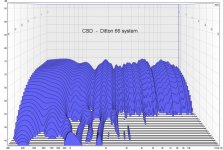
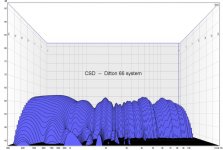
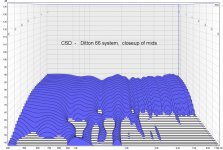
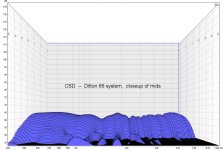
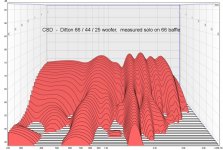
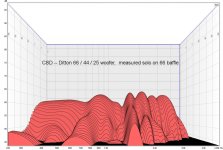
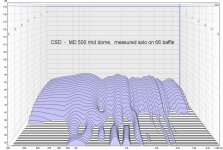
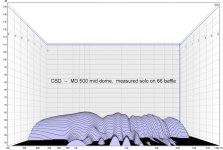
From the D’Appolito article--
"Resonances appear as ridges moving forward along the time axis…
Detection threshold for resonances: very narrow resonances (high Q) must be about 10dB above the average level to be heard, whereas very broad resonances need only be 1 to 2dB higher to be detected...
Diffraction effects can also produce response peaks and dips. These peaks and dips may persist in the CSD and be confused with resonances. Fortunately, diffraction responses are angle dependent and can often be isolated by looking at off-axis responses. Off axis response plots are more useful for identifying diffraction."
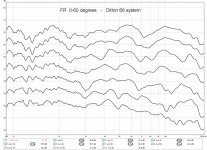
"Resonances are inherent in the speaker response and will persist at all off-axis angles… Diffraction responses, however, are angle dependent and tend to disappear off-axis.”
Sorry to say I didn't read all of the info so forgive if I cover the same ground ? Did anyone debate the effects of the tweeter lens ? Celestion would not have had such tools as we now can buy cheaply . I wonder how good their estimation of the tradeoffs is ? One could question if later tweeters from respected designers were as good having none ?
I know the Spendor designs favoured this tweeter if memory is correct ? Spendor used a STC 4001 G super tweeter crossing over at 10 kHz . The STC I think was a modified AKG microphone capsule dating back to 1959 ?
I know the Spendor designs favoured this tweeter if memory is correct ? Spendor used a STC 4001 G super tweeter crossing over at 10 kHz . The STC I think was a modified AKG microphone capsule dating back to 1959 ?
Same Ole speaker data, but new presentation 
Waterfalls of the woofer--
CSDs - Ditton 66 woofer, solo
Waterfalls of newer model mid dome--
CSDs - Ditton Md 500 dome, solo
Waterfalls of older model mid dome--
CSDs - Ditton Mf 500 dome, solo
Waterfalls of the treble--
CSDs - Ditton 66 treble
Waterfalls of the Ditton 66--
CSDs - Ditton 66 system
FR & IR plots--
FR & IR - Ditton 66
.
Waterfalls of the woofer--
CSDs - Ditton 66 woofer, solo
Waterfalls of newer model mid dome--
CSDs - Ditton Md 500 dome, solo
Waterfalls of older model mid dome--
CSDs - Ditton Mf 500 dome, solo
Waterfalls of the treble--
CSDs - Ditton 66 treble
Waterfalls of the Ditton 66--
CSDs - Ditton 66 system
FR & IR plots--
FR & IR - Ditton 66
.
Speaker testing advice
Thanks Alan for your last post,
I've read the interesting papers by D'Appolito and will take your advice on the method when I retest the drivers. When that will be I can't say at the moment. I need a USB audio interface for my laptop so welcome any suggestions on what people are using.
The references in one paper refers to John Atkinson's work on measurements in Stereophile. From this I came across a lecture he gave in 2011 which looks interesting:
RMAF11: Loudspeaker Measurements Explained, John Atkinson, Stereophile Editor - YouTube
Thanks Alan for your last post,
I've read the interesting papers by D'Appolito and will take your advice on the method when I retest the drivers. When that will be I can't say at the moment. I need a USB audio interface for my laptop so welcome any suggestions on what people are using.
The references in one paper refers to John Atkinson's work on measurements in Stereophile. From this I came across a lecture he gave in 2011 which looks interesting:
RMAF11: Loudspeaker Measurements Explained, John Atkinson, Stereophile Editor - YouTube
Hello all. Sorry for this long (and selfish) post. Alan, thank you for your invitation (Post #853) to detail the xovers from my black-faced 66’s. These have been attacked thrice now. The first in the mid 90’s - when the capacitors were replaced/bi-wiring installed and new no-name tweeters replaced the burnt out HF2000’s – and again late last year when I acquired some Hiqaphon OW2’s and then last week when I decided to implement some of your recommendations (also Post #853). So, what I will do is give the component number first (from the original TBC schematic) and the original 1976 factory value then the 1990’s value then the current 2012 value:
Bass:
C1. 72uf/68uf Solens/68uf Solens + 1x 10W 1 Ohm Mox R*
C2. 72uf/68uf Solens/68uf Solens + 1 x 10w 1.5 Ohm Mox R*
L2. 2.2mh coil/same/same
L3. 3.5mh coil/same/same
Mid:
C3. 4uf/3.9uf Solens/3.9uf Solens + 1x 10W 2.7 Ohm Mox R*
C4. 6uf/Nil/Nil
C5. 24uf/2 x 15 Solens/22uf Mundorf MCap + 1x 10W 1.8 Mox R*
L1. 2.2mh coil/same/same
L4. 0.35mh coil/same/same
Tweet:^
C6/7/8. 4uf/3.9uf Solens/3.9 Solens
C9/10/11/12. 6uf/8.2uf Solens/8.2uf Solens
L5. 0.14mh coil/same/same
*these from DennyG’s schematic.
^plus an LPAD on tweeter terminals consisting of 1 x 10W 1 Ohm + 1x 10W 1.5 Ohm Jaycar resistors (like a block of white chalk).
Anyway, I’ve been listening for a week now and I must say I am pleased with the outcome. The first CD I put on was (snigger) Leonard Cohen to get the voice thing happening. It seemed much bigger then I remembered. Much deeper, like it was coming from the mid and the bass drivers. So, after many CD’s, I’ve formed the opinion that (a) I’m getting greater clarity (b) I’m getting better balance between the drivers (c) I've lost a tiny bit of volume (d) after a week’s listening I don’t know what changes I hear anymore but (e) a very good upgrade for $60 and 1 hours labour. I was also going to detach the tweeter circuit as you recommended Alan but unfortunately the schematic bore no relationship to what I saw in the cabinet. As a very literal person I was confused by the [apparent] randomness of the wiring in my xovers. But, I did find the source of a persistent hum in one channel. A bad solder joint (connecting the 2 bass inductors) that came apart when prodded. So, I feel emboldened to try for a xover of my own (leaving aside the replacement Morel mid for the moment). Alan could you advise me further please. I think I have seen at least three, maybe more, schematic’s on this thread: Moermusic’s Post #659, Patrick Dixon’s Post # 844 and DennyG’s Post # 845. What I think I would like to see included is:
.Anti Cables 12awg solid copper wire from amplifier to drivers (I dislike stranded wire)
.Bass. 2 x 70uf Obbligato Paper in Oil + those new Jantzen coils you mention at Posts 652/655
.Mid. 1x 22uf Mundorf Supreme + 1 x 1.8uf + 1 x 2.2 Mundorf Supreme [summing to 4uf and both the same size} + standard coils
.Tweeter. Not sure. Depends on what your advice is. Maybe Obbligato gold if they have appropriate uf values. Plus of course the ESL suppressing resisors.
Well, thank you for reading and hopefully you can give me some [more] good advice.
Regards, Reggie.
Bass:
C1. 72uf/68uf Solens/68uf Solens + 1x 10W 1 Ohm Mox R*
C2. 72uf/68uf Solens/68uf Solens + 1 x 10w 1.5 Ohm Mox R*
L2. 2.2mh coil/same/same
L3. 3.5mh coil/same/same
Mid:
C3. 4uf/3.9uf Solens/3.9uf Solens + 1x 10W 2.7 Ohm Mox R*
C4. 6uf/Nil/Nil
C5. 24uf/2 x 15 Solens/22uf Mundorf MCap + 1x 10W 1.8 Mox R*
L1. 2.2mh coil/same/same
L4. 0.35mh coil/same/same
Tweet:^
C6/7/8. 4uf/3.9uf Solens/3.9 Solens
C9/10/11/12. 6uf/8.2uf Solens/8.2uf Solens
L5. 0.14mh coil/same/same
*these from DennyG’s schematic.
^plus an LPAD on tweeter terminals consisting of 1 x 10W 1 Ohm + 1x 10W 1.5 Ohm Jaycar resistors (like a block of white chalk).
Anyway, I’ve been listening for a week now and I must say I am pleased with the outcome. The first CD I put on was (snigger) Leonard Cohen to get the voice thing happening. It seemed much bigger then I remembered. Much deeper, like it was coming from the mid and the bass drivers. So, after many CD’s, I’ve formed the opinion that (a) I’m getting greater clarity (b) I’m getting better balance between the drivers (c) I've lost a tiny bit of volume (d) after a week’s listening I don’t know what changes I hear anymore but (e) a very good upgrade for $60 and 1 hours labour. I was also going to detach the tweeter circuit as you recommended Alan but unfortunately the schematic bore no relationship to what I saw in the cabinet. As a very literal person I was confused by the [apparent] randomness of the wiring in my xovers. But, I did find the source of a persistent hum in one channel. A bad solder joint (connecting the 2 bass inductors) that came apart when prodded. So, I feel emboldened to try for a xover of my own (leaving aside the replacement Morel mid for the moment). Alan could you advise me further please. I think I have seen at least three, maybe more, schematic’s on this thread: Moermusic’s Post #659, Patrick Dixon’s Post # 844 and DennyG’s Post # 845. What I think I would like to see included is:
.Anti Cables 12awg solid copper wire from amplifier to drivers (I dislike stranded wire)
.Bass. 2 x 70uf Obbligato Paper in Oil + those new Jantzen coils you mention at Posts 652/655
.Mid. 1x 22uf Mundorf Supreme + 1 x 1.8uf + 1 x 2.2 Mundorf Supreme [summing to 4uf and both the same size} + standard coils
.Tweeter. Not sure. Depends on what your advice is. Maybe Obbligato gold if they have appropriate uf values. Plus of course the ESL suppressing resisors.
Well, thank you for reading and hopefully you can give me some [more] good advice.
Regards, Reggie.
interim to DennyG and Reggie
G'day Denny,
I don't know much about USB audio interfaces except that some apparently work better than others,
at least for listening to music, but such degree of quality may not be necessary for test signals for measurement,
EXCEPT if they compress the signal level and/or have excessively limited high frequency bandwidth,
because then you won't get valid results.
If I remember something more I will post it, but whatever may be an expensive brand.
Do you want an interface for listening to music also, or only for test measurements ?
Hopefully when sba next reads here he may be able to recommend something.
The John Atkinson lecture includes things I have read in his articles in Stereophile,
and there is a lot of useful stuff, though one does not need it all for what we are doing here,
however there are some other things that I think are relevant to what some of us hear from loudspeakers that J.A. does not mention or emphasize sufficiently,
but as there are distinctly different priorities accorded by some peoples' brains to sound perception than to other peoples' I intend no slur on J.A. ,
and I do respect his experience.
--- --- --- --- ---
G'day Reggie,
ahem, ... do you actually have 1 ohm and 1.5 ohm in the tweeter L-pad ?
If so, then expect problems, and more if you play your amp loudly and its output stage burns out.
With reference to the L-pad resistors' positions in #844:
put 15 ohms in the Parallel to tweeter position if you have not such there.
A cheap Jaycar 5 watt or 10 watt will be OK there for now,
and with your 1 ohm or 1.5 ohm in the Series position.
Neither 15 ohm, nor 10 ohm, in Parallel will be ideal for the Hiqaphon, but will be safe for your amplifier.
Before we decide on optimising the Impedance around the Hiqaphon
I need to know the limitations of capacitor values you can buy.
As you have consistently mentioned Mundorf since your earliest posts, I am wondering if you will only buy from an Australian seller,
because if so, the tweeter impedance will have to be made suitable for the limited options of capacitance from Mundorf { and Obbligato }
versus the larger number of options from SoniCap from USA.
Are you buying from:
Hifi, Car Audio, Pro Audio and DIY - Soundlabs Group Online
or from who/where ?
Also, are you hearing sufficient or not enough treble ?
and is your wife hearing sufficient or too much treble ?
with the speakers as they are now.
G'day Denny,
I don't know much about USB audio interfaces except that some apparently work better than others,
at least for listening to music, but such degree of quality may not be necessary for test signals for measurement,
EXCEPT if they compress the signal level and/or have excessively limited high frequency bandwidth,
because then you won't get valid results.
If I remember something more I will post it, but whatever may be an expensive brand.
Do you want an interface for listening to music also, or only for test measurements ?
Hopefully when sba next reads here he may be able to recommend something.
The John Atkinson lecture includes things I have read in his articles in Stereophile,
and there is a lot of useful stuff, though one does not need it all for what we are doing here,
however there are some other things that I think are relevant to what some of us hear from loudspeakers that J.A. does not mention or emphasize sufficiently,
but as there are distinctly different priorities accorded by some peoples' brains to sound perception than to other peoples' I intend no slur on J.A. ,
and I do respect his experience.
--- --- --- --- ---
G'day Reggie,
ahem, ... do you actually have 1 ohm and 1.5 ohm in the tweeter L-pad ?
If so, then expect problems, and more if you play your amp loudly and its output stage burns out.
With reference to the L-pad resistors' positions in #844:
put 15 ohms in the Parallel to tweeter position if you have not such there.
A cheap Jaycar 5 watt or 10 watt will be OK there for now,
and with your 1 ohm or 1.5 ohm in the Series position.
Neither 15 ohm, nor 10 ohm, in Parallel will be ideal for the Hiqaphon, but will be safe for your amplifier.
Before we decide on optimising the Impedance around the Hiqaphon
I need to know the limitations of capacitor values you can buy.
As you have consistently mentioned Mundorf since your earliest posts, I am wondering if you will only buy from an Australian seller,
because if so, the tweeter impedance will have to be made suitable for the limited options of capacitance from Mundorf { and Obbligato }
versus the larger number of options from SoniCap from USA.
Are you buying from:
Hifi, Car Audio, Pro Audio and DIY - Soundlabs Group Online
or from who/where ?
Also, are you hearing sufficient or not enough treble ?
and is your wife hearing sufficient or too much treble ?
with the speakers as they are now.
Last edited:
Reggies New Xover
Hello Alan, thank you for your response (post #898). The resistor on the tweeter LPad is indeed a10w 15 Ohm (not 1.5 Ohm). My typing error. Apropos to my wife's hearing; it is phenomonal. She can hear my wristwatch alarm when it is in its case in my sock draw in the bedroom 20 feet from where we are watching TV. As to the current tweeter iteration she does not find them overly bright or shrill. In general she thinks my stereo is very engaging and lifelike. NB. My wife is not into hifi (or cars) and is generally happiest listening to the ABC talkback station on her transistor radio. The only issue she has ever had with them is when I asked for her appraisal of the 3 tweeters I was trying out and the glare from the straight Hiqophon (I forgot the LPad) made her leave the room. As for me, it depends. If I am listening to a well recorded CD or a small ensemble I do not feel/think that I am missing much. But, on many so so recordings I get the impression the higher frequencies have been mixed too far back and I am not getting all the picture. By the by I am not at all sure where the tweeter take over from the mid . Is it in the violins or cymbals? Same again between the bass and the mid. What should I be listening for? With the recent changes you suggested I think I'm hearing more upper bass but that's not possible is it? Anyway, with regard to the make-up of my new crossovers I admit to being guided by the capacitor testing done by humblehomemadehifi. He appears to be the only one to test capacitors in a cossover scenario and I am leaning toward the Obbligato's and the Jantzen Superior Z's (I know I mentioned Mundorf in my last post but that was brain fade from a head cold I have been suffering from this past week). The Obbligato's bcause of their outright cheapness and the Jantzen because of their relative cheapness (vis a vis their relative scores in the comparison). I would like to at least try the Obbligato 70uf film oil in the bass and the Jantzen elsewhere (mainly because the Obbligato don't seem to make the relative values required). I would be buying the Obbligato from DIYHiFi and the Jantzen coils and capacitors from Speakerbug here in Australia. Well, that's it. As always any advice you can give will be greatly appreciated.
Regards
Reggie
Hello Alan, thank you for your response (post #898). The resistor on the tweeter LPad is indeed a10w 15 Ohm (not 1.5 Ohm). My typing error. Apropos to my wife's hearing; it is phenomonal. She can hear my wristwatch alarm when it is in its case in my sock draw in the bedroom 20 feet from where we are watching TV. As to the current tweeter iteration she does not find them overly bright or shrill. In general she thinks my stereo is very engaging and lifelike. NB. My wife is not into hifi (or cars) and is generally happiest listening to the ABC talkback station on her transistor radio. The only issue she has ever had with them is when I asked for her appraisal of the 3 tweeters I was trying out and the glare from the straight Hiqophon (I forgot the LPad) made her leave the room. As for me, it depends. If I am listening to a well recorded CD or a small ensemble I do not feel/think that I am missing much. But, on many so so recordings I get the impression the higher frequencies have been mixed too far back and I am not getting all the picture. By the by I am not at all sure where the tweeter take over from the mid . Is it in the violins or cymbals? Same again between the bass and the mid. What should I be listening for? With the recent changes you suggested I think I'm hearing more upper bass but that's not possible is it? Anyway, with regard to the make-up of my new crossovers I admit to being guided by the capacitor testing done by humblehomemadehifi. He appears to be the only one to test capacitors in a cossover scenario and I am leaning toward the Obbligato's and the Jantzen Superior Z's (I know I mentioned Mundorf in my last post but that was brain fade from a head cold I have been suffering from this past week). The Obbligato's bcause of their outright cheapness and the Jantzen because of their relative cheapness (vis a vis their relative scores in the comparison). I would like to at least try the Obbligato 70uf film oil in the bass and the Jantzen elsewhere (mainly because the Obbligato don't seem to make the relative values required). I would be buying the Obbligato from DIYHiFi and the Jantzen coils and capacitors from Speakerbug here in Australia. Well, that's it. As always any advice you can give will be greatly appreciated.
Regards
Reggie
I don't know if I ever gave this link ? He is very knowledgeable . The LS3/5A tackled and succeed with these problems . Many say LS3/5A is it's crossover . I like the transformer coupling to the tweeter . An auto transformer I see as ideal . I think it might pass what we want and damp that which we don't ? It is a notion and not something I have devoted mathematical time to ( too lazy these days ) . I would not like an isolation type for many reasons , the amount of iron is one .
Falcon Acoustics | The Leading DIY Speaker Parts and Kit Supplier since 1972
Falcon Acoustics | The Leading DIY Speaker Parts and Kit Supplier since 1972
- Status
- This old topic is closed. If you want to reopen this topic, contact a moderator using the "Report Post" button.
- Home
- Loudspeakers
- Multi-Way
- Celestion 66 needs mid-range
